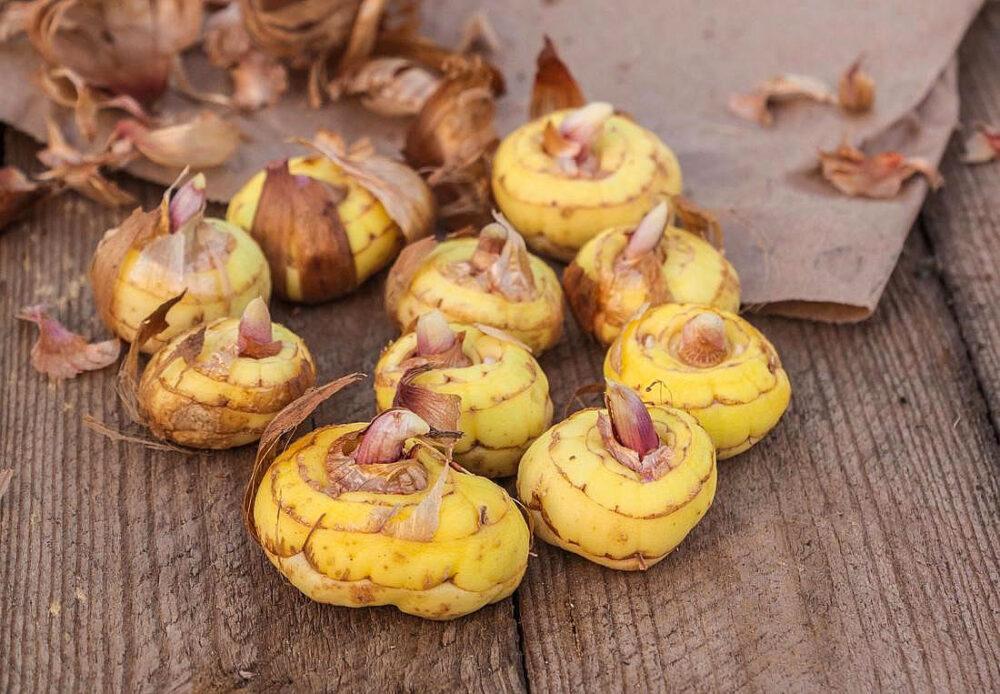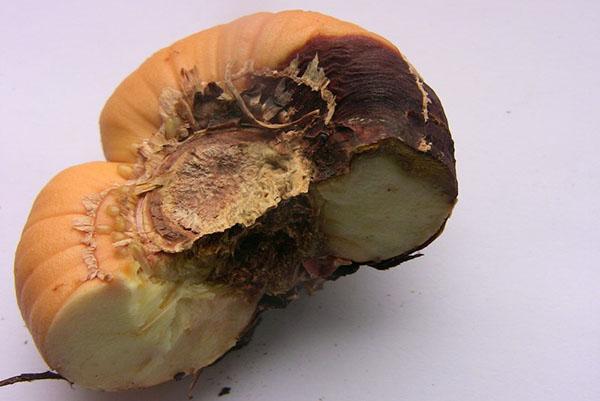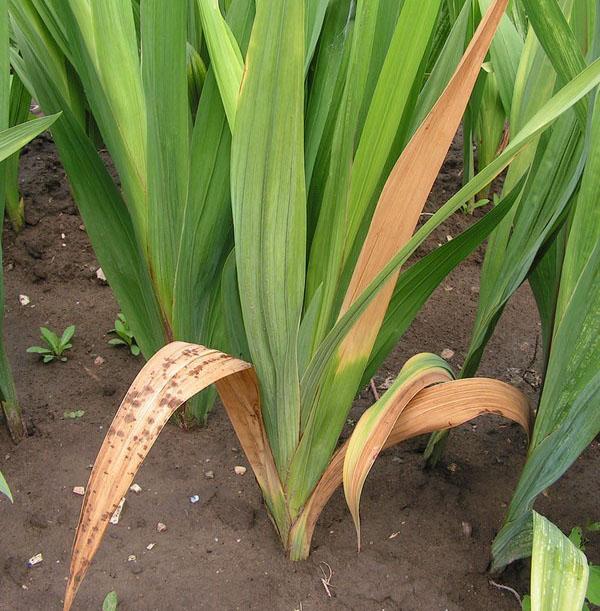Diseases of gladioli and their treatment: photos of characteristic symptoms
 Gladiolus is one of the most spectacular garden flowers, and it is doubly upsetting when the plants wither, the buds do not open, and the corms rot. To prevent this from happening, you need to know the diseases of gladioli and their treatment, and photos and descriptions of the most common problems will help to cope with them in time.
Gladiolus is one of the most spectacular garden flowers, and it is doubly upsetting when the plants wither, the buds do not open, and the corms rot. To prevent this from happening, you need to know the diseases of gladioli and their treatment, and photos and descriptions of the most common problems will help to cope with them in time.
Most often, flower growers are faced with diseases caused by bacteria, harmful fungi and viruses. Pests that are dangerous to bulbous crops can also cause a lot of troubles.
Fungal diseases of gladioli and their treatment

One of the most dangerous and incredibly common problems is fusarium or dry rot. As you can see in the photo, without treatment, gladiolus disease leads to the appearance of brownish-red concave putrefactive spots on the bulbs. If such a plant is planted, even with a small degree of infection, the leaves that appear turn yellow and dry out. And this is a sure sign of decay and death of the root system.
Depending on the stage and time of the defeat by fusarium, gladiolus dies before flowering or still forms an inflorescence. But when a bulb infected with fusarium is stored, the spores of the fungus disperse, falling on healthy planting material.
 Therefore, it is so important to select the bulbs very carefully for storage. However, the spread of dry rot is facilitated not only by an oversight of the grower, but the use of fresh manure whether low-quality humus. If bulbs with signs of Fusarium are found in the fall, the site becomes unsuitable for growing this flower crop for 3-4 years.
Therefore, it is so important to select the bulbs very carefully for storage. However, the spread of dry rot is facilitated not only by an oversight of the grower, but the use of fresh manure whether low-quality humus. If bulbs with signs of Fusarium are found in the fall, the site becomes unsuitable for growing this flower crop for 3-4 years.
Another dangerous gladiolus disease, the treatment and prevention of which requires special attention, is gray, brown rot or botrythiasis. The spread of the causative agent of the disease is facilitated by cool, wet weather, when spores of the fungus are carried by wind and rain from the soil and diseased plants to healthy ones.
In a couple of weeks, reddish spots appear en masse on the leaves of blooming gladioli. The disease affects flowers, which quickly lose their shape and decorativeness. If the rains do not stop, the stems rot, from which the rot will turn into corms. When digging, it is noticeable that the bottom of the diseased bulb softens or completely fails.
 The photo showing the disease of gladiolus is a bulb that cannot be treated, with a penetrating lesion of the core. It is important to destroy the spoiled planting material by first collecting children without signs of disease from the bulbs.
The photo showing the disease of gladiolus is a bulb that cannot be treated, with a penetrating lesion of the core. It is important to destroy the spoiled planting material by first collecting children without signs of disease from the bulbs.
Sclerotinosis, also called black rot, is more common on dense, acidic soils and spreads with cold rain. At first, signs of the disease become noticeable on the brown foliage, then the rotting stem softens and falls. The affected tissue shows black areas inseminated by fungi. Rotting covers the corm, its roots from white turn brown, softened and rotted away.
On the surface of the gladiolus bulb itself, the disease, the treatment of which, like all fungal diseases does not exist, makes itself felt by the formation of brown or dark brown spots growing around the circumference.
As a result, a patient with sclerotinosis planting material dries up, and the infection passes to the formed daughter corms. Therefore, diseased plants are completely destroyed, including children.
 Septoria in appearance resembles other fungal diseases of gladioli, as in the photo, while there is no treatment, except for the prevention and complete destruction of damaged bulbs and stems and leaves containing spores of the fungus.
Septoria in appearance resembles other fungal diseases of gladioli, as in the photo, while there is no treatment, except for the prevention and complete destruction of damaged bulbs and stems and leaves containing spores of the fungus.
Bacterial diseases of gladiolus bulbs, their treatment and photos
 Diseases of a bacterial nature include root cancer, scab and a number of other problems, the signs of which can be more often seen on the bulbs of gladioli. Harmful bacteria enter the plant from the soil. With scab, they cause the formation of a kind of erosion on the body of the bulbs, and from the aboveground side, the symptoms of this disease are hardly noticeable. Only near the ground itself can you see brown or reddish spots, which, without taking agrotechnical measures, grow and cause rotting of the base of the stem.
Diseases of a bacterial nature include root cancer, scab and a number of other problems, the signs of which can be more often seen on the bulbs of gladioli. Harmful bacteria enter the plant from the soil. With scab, they cause the formation of a kind of erosion on the body of the bulbs, and from the aboveground side, the symptoms of this disease are hardly noticeable. Only near the ground itself can you see brown or reddish spots, which, without taking agrotechnical measures, grow and cause rotting of the base of the stem.
Signs of untreated gladiolus disease, as in the photo, are clearly visible when the bulbs are harvested and dried.
Root carcinoma also shows up on already dug out bulbs as watery, greenish-yellow formations that can be easily separated from the underlying tissue. The cause of the disease is the activity of bacteria that change the "program" of cells responsible for the formation of children.
 There is no cure for this disease of gladiolus bulbs, as in the photo, and the main struggle is prevention, that is, the destruction of bacterial flora and pests that spread disease, including nematodes.
There is no cure for this disease of gladiolus bulbs, as in the photo, and the main struggle is prevention, that is, the destruction of bacterial flora and pests that spread disease, including nematodes.
Viral diseases of gladioli
 In recent years, flower growers have increasingly complained about the spread of viral diseases of gladioli, the most famous of which is mosaic disease. It manifests itself as a chaotic alternation of light and dark spots or stripes on the leaves, and then on the flowers of the plant.
In recent years, flower growers have increasingly complained about the spread of viral diseases of gladioli, the most famous of which is mosaic disease. It manifests itself as a chaotic alternation of light and dark spots or stripes on the leaves, and then on the flowers of the plant.
The mosaic negatively affects not only the color, but also the growth of gladiolus. Such a specimen lags behind neighboring plants, its inflorescences contain fewer buds, and the flowers themselves are smaller.
The bulb outwardly practically does not suffer, but with insects feeding on gladiolus juices and inventory, the disease passes to healthy plants.
 Viruses also cause such a disease of gladioli as overgrowth. An outwardly healthy bulb, after planting, forms extremely weak filamentous shoots or does not intend to develop at all. The disease is not treated, and the planting material with its symptoms is destroyed.
Viruses also cause such a disease of gladioli as overgrowth. An outwardly healthy bulb, after planting, forms extremely weak filamentous shoots or does not intend to develop at all. The disease is not treated, and the planting material with its symptoms is destroyed.
Methods of struggle and treatment of diseases of gladioli
 The main weapon in the fight against gladiolus diseases is targeted prevention, which consists of:
The main weapon in the fight against gladiolus diseases is targeted prevention, which consists of:
- in the establishment of agricultural technology;
- in the elimination of pests dangerous for flower culture;
- in organizing the correct selection and storage of bulbs.
The spread of fungal infections and all kinds of rot is facilitated by overcrowding of plantings, improper selection of fertilizers or the type of soil.
The abundance of nitrogen during flowering and closer to autumn, for example, can weaken the plant, prevent the bulb from ripening in time, and expose it to the danger of attack by bacteria and soil pests.
Therefore, in the second half of the growing season, gladioli should be fed with potash fertilizers with a minimum addition of nitrogen and phosphorus.
In order not to expose plants to the danger of infection with untreated diseases, gladioli can be planted after deep digging of the soil. It is useful if marigolds, calendula, nasturtiums, parsley grew on the site before. These plants gently and safely disinfect the soil, repelling soil pests that often spread bacterial diseases.
 To the greatest extent, this applies to such pests that spread diseases of gladioli as the wireworm shown in the photo, various types of nematodes, and grubs.
To the greatest extent, this applies to such pests that spread diseases of gladioli as the wireworm shown in the photo, various types of nematodes, and grubs.
Newly purchased bulbs should not be immediately planted with proven planting material.First, such gladioli are sent to quarantine, that is, to a site separated from the main plantation.
It is important to plant flowers on time, otherwise:
- rooting is slower in overheated soil, gladiolus looks depressed, stunted and often becomes an easy prey for pests;
- in cold soil, the plant is threatened by rot pathogens.
As an effective disease control measure, regular loosening of the soil under plantings, the introduction of growth-supporting dressings and watering are used.
 To disinfect the area after gladioli, the soil is spilled with a 2% solution of copper sulfate. It is categorically impossible to delay the harvesting of bulbs, which are threatened not only by freezing, but also by the penetration of soil pests, fungi and bacterial flora into the larvae.
To disinfect the area after gladioli, the soil is spilled with a 2% solution of copper sulfate. It is categorically impossible to delay the harvesting of bulbs, which are threatened not only by freezing, but also by the penetration of soil pests, fungi and bacterial flora into the larvae.
How to treat gladioli before planting from diseases
 If there are no alarming symptoms, and outwardly the corms are healthy after storage, how to treat gladioli before planting from diseases?
If there are no alarming symptoms, and outwardly the corms are healthy after storage, how to treat gladioli before planting from diseases?
As a prophylaxis, the corms selected for planting are soaked for half an hour in a dense pink solution of potassium permanganate. Bathing the bulbs in a slightly blue solution of copper sulfate helps from the danger of fungal infection.
After harvesting, undried bulbs can be washed and poured with hot water for a few minutes, when it cools down, repeat the procedure. The optimum temperature is 45–55 degrees. This is followed by treatment with cold water and another rinsing. Plain water will help remove fungi from the bulbs, rinse the places where bacteria accumulate, and get rid of nematodes and thrips.
Before planting, the corms are immersed for 18 hours in a 0.5% solution of thiourea, which works as a fertilizer and an effective fungicide. This product cleans and disinfects light bulbs with fungal infections.
From the second half of July, plants are treated twice or three times with an interval of 1-2 weeks with a 2% solution of karbofos. An excellent prevention against fungus will be spraying gladioli with a solution of copper oxychloride at the rate of 5 grams per bucket of water.
Treatment of gladioli for diseases before planting - video